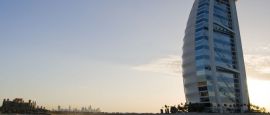United Arab Emirates Weather, climate and geography
Weather & climate
The UAE draws sunseekers from all corners of the globe due to the fact that it is blessed with year-round sunshine, blue skies and very little rain. The best time to visit is between October and April, when temperatures hover at a pleasant 25-28°C (77-82°F) and the Gulf is perfect for swimming. The hottest time of year is during the sweltering summer months of June to September, when humidity can seem unbearable and temperatures can skyrocket to 45°C (113°F). The country is well prepared for hot weather, however, with temperature controlled swimming pools and permanently air-conditioned hotels, malls, taxis and metros. Rain and wind can occur in January through March.
Layering is your best bet; wear light clothing outside and bring a jumper or sweatshirt for the heavily air-conditioned buildings around the cities. During November to March, warmer clothes are advised for evening. A hat and high factor sun block is also advisable - a day on the beach in the strong summer sun is an easy recipe for sunstroke and sunburn. If visiting during the summer, make like the residents and visit the beaches early in the morning and later in the evening.
Geography
The UAE sits at the top right hand corner of the Arabian Peninsula bordered by Oman in the east and Saudi Arabia in the south. All of the Emirates bar one sit on the on the Persian Gulf opposite Iran, and cover a distance spanning 650 km (404 miles) along the coastline. Fujairah is the only Emirate that sits on the Gulf of Oman. The UAE covers an area of 83,600 sq km (32,300 sq miles), Abu Dhabi covers 87% of the country's land mass, which has a consistent terrain of mainly desert. It is home to native animals such as gazelles and the Arabian oryx, which was reintegrated into the area 40 years after it was hunted to extinction. Whilst 80% of the land mass is desert, other ecological terrain includes mountain areas and marine coastal areas.
The highest recorded point in the country is an unnamed peak stretching 1,910m (6266ft) high near the Jabal Bil Ays in Oman (but within the UAE border). The lowest point is at the Persian Gulf. The country only has 3.8% forest and woodlands due to the arid conditions. In an oasis is it common to find date palms, acacia and eucalyptus trees. Sand storms are common in the UAE, and this can cause traffic on the roads due to the poor visibility.
Off the coast of Fujairah the waters are rich in calcium carbonate, and make the ideal breeding ground for coral reefs such as alveopora coral, African pillow coral, brain coral, raspberry-rice coral and more. The marine life in the area is rich due to these diverse coral formations and species in the area include Arabian carpet sharks, areloate groupers, black-finned melon butterfly fish, blacktip reef sharks, parrot fish and even whale sharks, which can be spotted by snorkellers and divers between the months of April and July.
Do you have any Feedback about this page?
© 2025 Columbus Travel Media Ltd. All rights reserved. No part of this site may be reproduced without our written permission, click here for information on Columbus Content Solutions.




 You know where
You know where